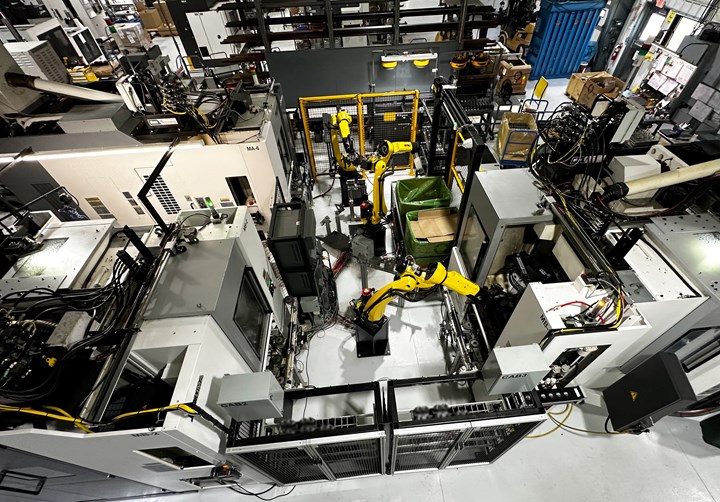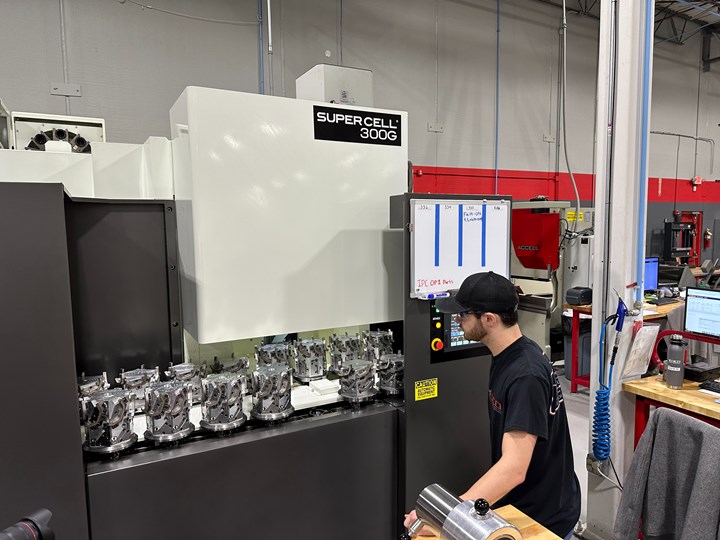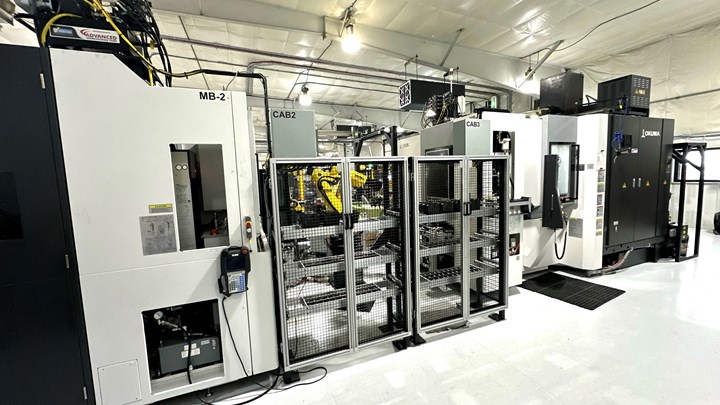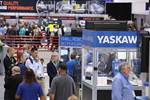Embracing Automation: Strategies for Small to Medium-Sized Machine Shops
Sponsored ContentBusiness drivers for automating to help navigate workforce challenges and boost profitability.

This automated robotic cell at MetalQuest frees employees from repetitive, manual tasks.
Source: MetalQuest
From the earliest days of automation at IMTS featuring a robot hand moving parts, there has been a massive evolution in technology. “What is the definition of automation?” asks Peter Eelman, chief experience officer for AMT. “Here’s an analogy. Think about a tool. Fifteen years ago, automation answered, ‘Is the tool broken?’ Then it became predictive, ‘Is the tool going to break?’ Then it was, ‘When is the tool going to break?’ Then, ‘Replace it before it breaks and have the replacement on hand.’ Now it’s a matter of designing the tool and the process around this information before machining even starts. All these steps have been part of automation, getting us to where we are today.”
And incorporating artificial intelligence (AI) operators can do much more, including using AI in part design to determine how to make a part in the most profitable way — sometimes even going from subtractive to additive manufacturing, if they have that capability.
As attendees walk the show floor at IMTS 2024 it is impossible to not see some type of automation in virtually every exhibitor’s booth. “It’s no longer about a company completing individual steps (of production), it’s everywhere – within machines, within product and external to product,” Eelman adds.
Automation may be difficult to define broadly, but it’s become a prerequisite for production, whether a shop has a single machine or is a huge manufacturer, according to Eelman. For IMTS 2024, automation will be on display in all 10 sectors, throughout all four buildings, and on every floor of McCormick Place. The next generation of manufacturing isn’t just coming, it’s here, and we urge you to embrace it.
Business Drivers for Automating
Whether you work, at a small shop with one machine or in a full production shop with dozens, gone are the days when automation was a nice to have. This doesn’t mean your entire shop needs to be filled with robots, but every shop owner should be looking at ways to add automation to your business to keep up with or surpass your competition. It isn’t about adding automation alone but about improving processes to increase profits and production efficiency.
Tim Shinbara, chief strategy officer for BlueForge Alliance and former chief technology officer at AMT, says that all business owners are aware of the challenge in hiring workers. “This isn’t unique to manufacturing, it’s the entire global workforce.”
The World Bank reported a drop of more than 4% in those of working age participating in the workforce from 1991 to 2022, and this number is expected to continue to drop due to an aging global population. “There just aren’t people to do the work in shops today so shop owners need to think differently and see automation as a necessity not just a nice to have,” Shinbara says.
The talent shortage is one of three primary drivers Shinbara cites as what is moving shops toward automating and also includes data integration and productivity that ties directly to profitability. And it’s not about the automation component itself, it’s about looking for ways to make processes better, he says.
So how can you decide where automation fits best in your business? A visit to IMTS 2024 is a great way to interface with suppliers and learn about what tools and systems are available. In the meantime, here are a few key considerations and advice from business owners and industry leaders on how to successfully add automation solutions to your workplace.
Defining Automation for Your Business
Thousands of shops have standalone machines that haven’t yet embraced automation, said Paul Van Metre, co-founder of ProShop ERP (IMTS booth #133027) and former machine shop owner. “I think many of them are under the misimpression that automation is solely for higher volume, lower mix types of work and that is no longer the case. And understanding that going all in on solutions like multi-pallet systems without shifts in operations like programming and standardization of cutting tools, shops will have a big investment without a great ROI because they won’t have spindle uptime to justify the cost,” he adds.

ProShop ERP keeps things running at Olson Custom Designs. Source: AMT.
Automation includes digital tools that create efficiencies across operations. Shops can automate part loading, tooling and part design, and inspection tools that feed data back into the process so improvements can be made on an ongoing basis and much more. Analyzing this data and interpreting it can drive business decisions from staffing to tool management and is the first of the three major reasons to automate that Shinbara mentions.
“What gets in the way of process improvements for many businesses is data inoperability or data exchanges,” Shinbara says. “Information exchange is better than before, as are data and cybersecurity. You can drag and drop modules and APIs instead of having to go back to your programmers to write more code.”
And using tools like artificial intelligence (AI) can even help determine what type of manufacturing and tooling is needed to make products most effectively. But there is a lot to consider when looking to automate your business.

This Kitamura horizontal machining center enables operators to perform one setup for unmanned machining for one-off or production parts at Olson Custom Designs. Source: AMT.
The second major driver is profitability. “Businesses can tie discrete costs to line items, and see places where they may lose quality, or where they’re spending extra time on setups and tooling changes losing efficiency,” Shinbara says. “They can use automation and digital tools like digital twins for simulation to make their processes more visible and control costs overall, reducing cycle times, minimizing setups and addressing backlogs so their machines are more productive,” also making job costing more accurate.
The last major consideration all shop owners need to consider is using automation to support and enhance their workforce. Getting input at the very beginning of the automation journey is critical to the long-term success and adoption by existing employees, and helps the entire process work more efficiently.
Lessons Learned From Automating
While there are several experts like Shinbara with knowledge of best practices, lessons learned and advice from other shop owners can be very valuable in your journey toward incorporating new technology into a shop. We spoke with several companies in different markets and employing different technologies to get their advice for shops that are looking to add some type of automation to their own businesses. Here are some of the highlights.
Incodema3D focuses on additive manufacturing technology for aerospace, defense and other industries. James Hockey, director of business development, says that at IMTS 2022 he found technology that could immediately impact the company’s business, a robotic system to move parts from machine to machine and operation to operation, reducing human intervention and saving time while increasing profits.

James Hockey, director of business development for Incodema3D. Source: Incodema3D
“We can do several setups in advance creating major efficiencies. In the past, one job took our operators between six and eight setups on different machines with different orientations to complete a part,” Hockey says. Staff would have to physically move the parts from one process and machine to the next and do new setups each time, requiring a lot of extra time and physical effort. But today it’s all been automated. This saves them time and physical labor stress and frees them up to do more challenging work. The team from Incodema3D will be attending IMTS 2024 in hopes of finding their next game-changing technology.
Nicole Wolter, CEO of power transmission component manufacturer HM Manufacturing, says she started thinking about automating in 2018 but didn’t jump in until the pandemic hit in 2020 and the shop was forced to run on limited staffing for social distancing and began falling behind on lead times.
“If I had done it in 2018, I would have avoided a lot of issues and playing catch up,” Wolter said. “We are running the factories of the future and we’re competing on a global scale. To get reshoring to continue and to compete with cheaper cost countries like India and Asia, and established automation in Europe, we need to be automating.”
For Wolter, with an average age of 32 on the shop floor, employees have embraced automation and like that robots can do the longer, more tedious runs while they work ahead on setups and programming. And she finds that the next generation of workers who were raised on computers and video games are looking for automation on the shop floor.
Scott Harms, manager at precision machine shop MetalQuest Unlimited, says businesses must approach robotic or automation projects with the mindset of trying to make employees’ jobs more enjoyable and to free them from repetitive and undesirable tasks, enabling them to do more fulfilling work. MetalQuest has done its own integration of 18 robots across the company and relies heavily on its employees to do this successfully.

MetalQuest’s automated Okuma cell. Source: MetalQuest
“The biggest advice I would give is any time you use robotics, literally every single thing a human being does within a process has to be accounted for with that robot – literally everything. They do the motions you tell them to do but don’t take into account variables that people just manage,” Harms says. This is no small feat and takes a lot of trial and error, so expecting automation to be plug and play will likely lead to disappointment.
Efficiency and Consistency For the Win
Attending IMTS 2024 is an easy way to see the best technology available today. “Even though it might be an uncomfortable problem to solve, it’s important that shops step up to the challenge and go to IMTS and look at tech, and learning from peers and vendors so their shops can ride this wave of manufacturing coming back,” said Van Metre. “There are vast opportunities on the horizon and they will be seized by the companies embracing technology.”
See what automation can do for you at IMTS 2024. Register now at IMTS.com/Register.
Partnering For Success
Finding an integrator to help implement automation in your shop can be invaluable, as they have experience across all sizes and industries in manufacturing so they can help avoid pitfalls. Acieta (IMTS booth #236419) is an industrial robotics automation company that has been doing this for decades.
Steve Alexander, vice president of Wisconsin operations and standard products at Acieta, says: "Robots are tools for growth, not replacement. They enable manufacturers to upskill their workforce, boost productivity, and create higher-quality jobs that fuel progress and prosperity. Integrating robotics means we're investing in people. We're creating opportunities for workers to learn, grow, and take on more rewarding roles. That's the real future of manufacturing."
Several Acieta customers have shared their success with implementing various types of automation in their organizations over the years. Here is some of their advice and experience.
Clow Valve Company, manufacturer of fire hydrants and waterworks valves: “Automation has reduced competitive work and hazardous tasks through using machines instead of staff to do heavy lifting and moving parts,” said the company’s previous machine shop plant manager. “For us, that’s as important as a financial return, and with that kind of payback it’s been one of our biggest drivers.”
AA Precision Tooling owner BJ Schrank has named his robot Penelope and said she is his favorite employee, after his daughter. “Penelope has changed my shop in ways that were unbelievable at first. I thought we were just going to do high production, one part after another. But as I started using her, I found out that she can deburr for me, she would keep me checking parts and do a lot more.” How much more? Schrank saw 60% more gross output on jobs Penelope was running, with high-quality parts at a consistent predictable output coming off the machine, enabling his employees to run more simultaneous operations and bring in more business.
Prince Hydraulics CEO Dan Van Eldik says the company started automating 30 years ago due to the same kind of capacity constraints many shops are seeing today, where finding enough talented workers to meet the throughput needs was a challenge. But keeping his people involved every step of the way has been critical to the success. He says that working with the people on the ideas goes a very long way. They raise challenges that automation overlooks that could cause the system to fail. “Robots are great tools for following orders and they can do just about anything that you can imagine – as long as there are rules and logic to drive them.”
MDS Manufacturing got into robotics to help its team become better welders, while eliminating fatigue on them and relieving production gaps in the manufacturing process. The company is a fabricator of buckets and attachments for tractors and work vehicles, many of which require dozens of repetitive operations in welding. Incorporating robotic welding cells enabled them to completely eliminate some operations due to more efficient welding patterns and efficiencies.




